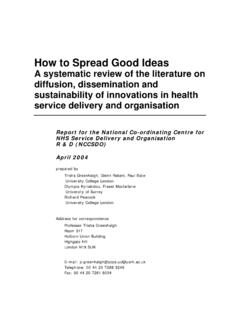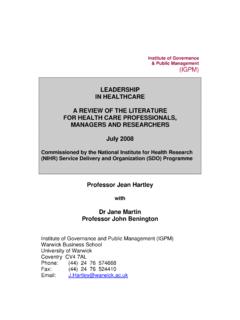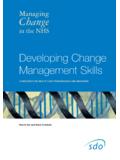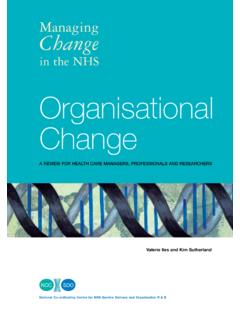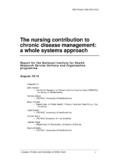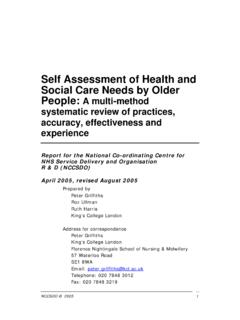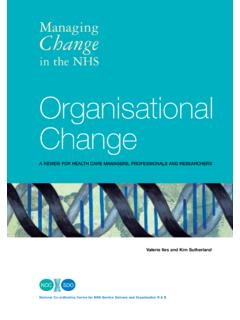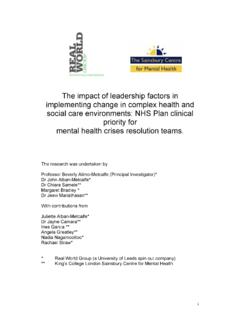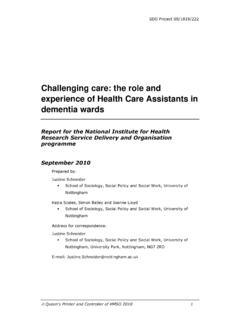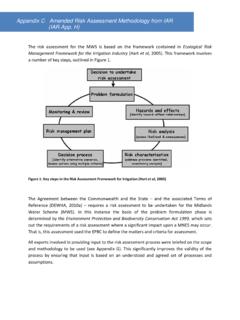Transcription of Extended Roles for Allied Health Professionals in …
1 Extended Roles for Allied Health Professionals in the NHS Report for the National Co-ordinating Centre for NHS Service Delivery and Organisation R & D (NCCSDO) February 2004 (revised July 2004) prepared by Kathryn McPherson Paula Kersten Steve George Val Lattimer Bridget Ellis Alice Breton Dawn Kaur Geoff Frampton Address for correspondence Kathryn McPherson Professor of Rehabilitation (Laura Ferguson Chair), Division of Rehabilitation and Occupation Studies, Auckland University of Technology, AA Building, Room 263, Private Bag 92006, Auckland, New Zealand E-mail: Telephone: +64 9 917 9999 ext 7110 Fax.
2 +64 9 917 9620 Extended Roles for Allied Health Professionals NCCSDO 2005 2 Contents Acknowledgements 4 Executive Summary Introduction 5 Specific implications and recommendations 6 The Report Section 1 Background to the study 8 Introduction 8 What is ESP? 9 Why the interest in ESP? 10 Interest in ESP at a government or macro level 10 Interest in ESP at a Health - professional level 11 Interest in ESP at the patient level 11 What is the level of knowledge about ESP in AHPs?
3 12 Objectives of the study 12 Section 2 Review methods 14 Selection criteria 14 Data management 14 Search strategy 15 Outcomes of interest 16 The review process 16 Abstract screening 16 Quality screening 16 Extraction of information or data 17 Section 3 Results 18 Summary of the review findings 18 Papers not considered in the review 18 Papers of direct relevance 18 Data extraction 19 Who is doing ESP research? 19 Why is ESP research being done? 19 Health - professional group data meeting data-extraction requirements 20 Radiography 20 Paramedics 22 Physiotherapy 25 Occupational therapy 26 Speech and language therapy 26 Descriptive findings regarding types of ESP in AHPs 27 Type of information 28 Why is ESP research being done?
4 28 Who is doing ESP? 28 Type of information by profession 29 Type of patients involved 29 Extended Roles for Allied Health Professionals NCCSDO 2005 3 Type of ESP 29 Perspective on ESP 30 Section 4 Discussion 33 Introduction 33 Issues arising across the AHP groups studied 33 Variability in terminology around ESP 33 Difficulties with including evaluation in clinically based Extended scope projects 34 Variability in training and education for ESP 34 Competence and legality of practice 35 Updating the review 36 Section 5 Conclusions 37 Introduction 37 Specific
5 Implications and recommendations 38 References 39 Appendices Appendix 1 Search strategy 41 1a Search strategy 41 1b Brief search strategy 46 Appendix 2 Study eligibility and evaluation 47 2a Abstract-screening form 47 2b Generic methodological screening form 49 2c Quality-screening summary form 55 2d Descriptive information-evaluation sheet 57 Appendix 3 Data-extraction database 59 Front page menu 59 Sheet 1 Type of intervention 60 Sheet 2 Drivers of ESP, quality summary and design 61 Sheet 3 Population, user involvement, professional group.
6 Location and funding 62 Sheet 4 Outcomes and bottom line 63 Appendix 4 Summary of search strategy results 64 Appendix 5 Studies included for data extraction 65 Appendix 6 Studies included for description only 67 Extended Roles for Allied Health Professionals NCCSDO 2005 4 Acknowledgements The research team would like to thank the contribution of individual practitioners in each of the professional groups concerned. In addition the team would like to acknowledge the contribution of the Steering Committee.
7 Whereas that contribution has influenced aspects of the project s design, responsibility for the study findings and the interpretation of those findings rests with the study team. Thanks also go to Veronika Zihl, Anya Kaushik and Claudia Fellmer, who also assisted in aspects of the review. Extended Roles for Allied Health Professionals NCCSDO 2005 5 Executive Summary Introduction Within the UK, efforts to modernise the Health service include a specific focus on reconsidering the Roles of non-medical members of the Health care team. This report details a research project utilising systematic review methods to elicit and critique published and unpublished literature about Extended scope practice (ESP) in five Allied Health profession (AHP) groups.
8 The main aim of this review was to identify, appraise and summarise Extended scope of practice in five Allied Health professional groups, thereby consolidating the evidence base for such innovations. Scoping the literature revealed an apparent dearth of robust evaluative research and the review therefore addressed two specific objectives or phases. Phase 1 To define the range of Extended or enhanced practitioner Roles within five Allied Health professional groups. Phase 2 To evaluate the effectiveness of Extended practice in Allied Health Professionals from published literature and other sources in relation to: the impact on patients, the impact on other Health Professionals , the impact on Health -services delivery (with a particular emphasis on the NHS).
9 Given the breadth of terminology used in the area, a broad search strategy was required and there were no limits according to time period or language. Over 7000 possible sources were identified, 355 of which contained information relevant to the topic. Twenty-two papers were of sufficient quality to be considered for data extraction with the remaining 333 considered for descriptive information only. The review found that despite the introduction of Extended scope Roles across all of the professional groupings considered,1 evidence about the impact of these new Roles is limited. To date, the main focus has been concerned with imperatives such as reduced demand on medical colleagues and reduced waiting lists.
10 The majority of reports were audits, satisfaction surveys, points-of-view papers or position statements. There were some individual case reports of note but there were few qualitative studies or robust trials. 1 Physiotherapy, occupational therapy, speech and language therapy, radiography and paramedics. Extended Roles for Allied Health Professionals NCCSDO 2005 6 The evidence considered in this review has suggested that AHP-ESP interventions can indeed contribute to improved ease and speed of access to specialist services that can be provided.
